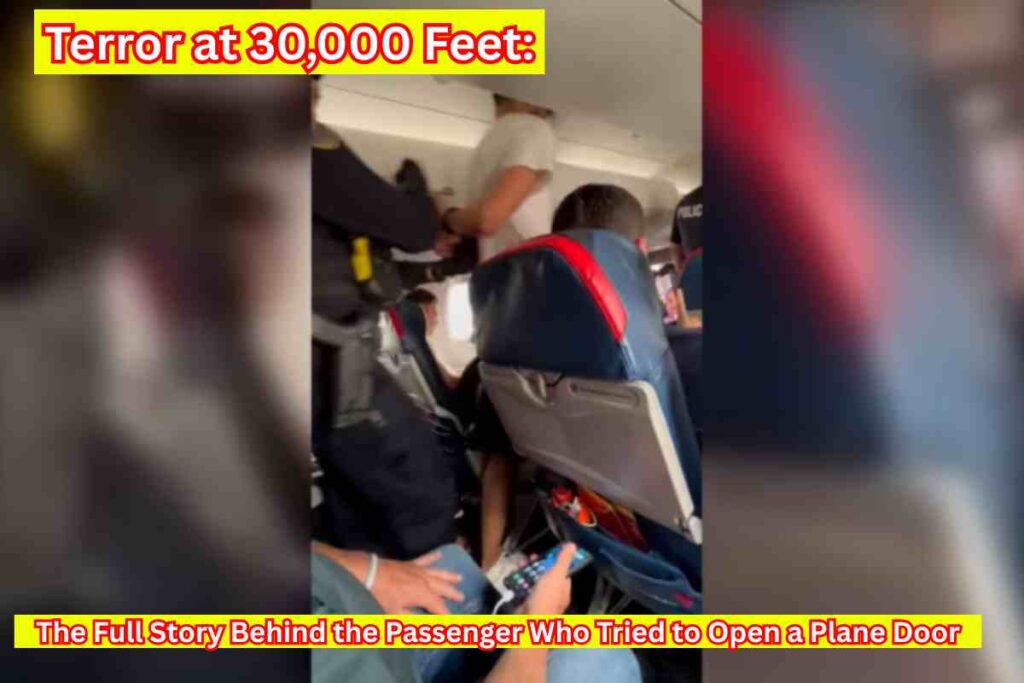Terror at 30,000 Feet: The Full Story Behind the Passenger Who Tried to Open a Plane Door

Terror at 30,000 Feet: The Full Story Behind the Passenger Who Tried to Open a Plane Door: The cabin of a commercial airliner at cruising altitude is a world unto itself. It is a place of suspended reality, where the gentle hum of the engines and the soft glow of reading lights create a bubble of tranquility against the vast, dark emptiness outside. It operates on a delicate social contract, an unspoken agreement among hundreds of strangers to be patient, respectful, and calm. But on a recent flight, that contract was violently shattered, plunging passengers and crew into a terrifying scenario that is every traveler’s deepest fear.
The incident was a stark and frightening reminder of the potential for chaos in a confined space, miles above the earth. A passenger, for reasons that are still being investigated, made a determined and desperate attempt to open one of the aircraft’s main exit doors mid-flight. The moments of panic that ensued, the heroic intervention of fellow passengers and crew, and the ultimate resolution of the crisis tell a story that is both alarming and, ultimately, reassuring.
This is not just the story of one dangerous incident. It is an opportunity to explore the alarming trend of unruly behavior in our skies, to understand the incredible physics that make our aircraft safer than we might imagine, and to appreciate the unseen professionalism of the flight crews we entrust with our lives.
The Incident: A Nightmare Unfolds
The flight had been unremarkable, a routine journey like thousands that crisscross the globe every day. Passengers were settled in, some watching movies, some sleeping, others reading. The flight attendants moved through the cabin with practiced efficiency. Then, the calm was broken.
According to eyewitnesses, a passenger abruptly left their seat and made a frantic dash towards one of the mid-cabin emergency exits. Shouts erupted as the individual began to pull and wrench at the large handle on the door, seemingly oblivious to the horrified gasps of those around them. For the passengers seated nearby, it was a moment of pure, unadulterated terror. The primal fear of the cabin door flying open, of being sucked out into the cold, thin air, is a deeply ingrained nightmare, fueled by decades of movie dramatizations.
What happened next was a testament to the courage of ordinary people and the rigorous training of the cabin crew. Before the passenger could continue their assault on the door, several other passengers jumped from their seats to intervene. Simultaneously, flight attendants converged on the scene. They are trained for these exact moments, and their training instantly kicked in. Using firm commands and practiced de-escalation techniques, they, along with the help of the brave passengers, subdued the individual.
The individual was restrained and moved to a secure location on the aircraft for the remainder of the flight. The captain immediately notified air traffic control of the security threat on board, requesting priority landing and law enforcement presence upon arrival. For the rest of the journey, the atmosphere in the cabin was thick with tension and anxiety, but the immediate threat was over. Upon landing, the plane was met by police officers who boarded the aircraft and took the passenger into custody. The individual is now facing serious federal charges.
The Myth vs. The Reality: Can You Actually Open a Plane Door Mid-Flight?
The heroic actions of the crew and passengers were absolutely necessary. The passenger’s behavior posed a significant threat to the safety and security of the flight. However, it is crucial to address the central fear: could they have actually succeeded in opening the door?
The answer, in short, is an emphatic no.
It is a common trope in action movies, but it is a scientific impossibility for any human being, or even a group of human beings, to open the main door of an airliner at cruising altitude. The reason comes down to two key factors: cabin pressurization and the design of the door itself.
At a typical cruising altitude of 30,000 to 40,000 feet, the air outside is far too thin to sustain human life. To keep passengers safe and comfortable, the aircraft is pressurized, meaning the air inside is compressed to simulate the atmospheric pressure of a much lower altitude (usually around 6,000 to 8,000 feet). This creates a massive pressure differential. The air inside the cabin is pushing outwards on every square inch of the plane’s fuselage with tremendous force.
Consider a standard exit door. The pressure on that door from the inside can be calculated to be over 1,100 pounds per square foot. For a typical door, this equates to a total outward force of several tons. It is a force that no person could possibly overcome.
Furthermore, almost all commercial aircraft doors are “plug doors.” This is a brilliant and simple piece of engineering. The door is slightly larger than the opening it seals. To close it, it is first moved into the opening and then pulled flush from the inside, seating it in place much like a cork in a bottle. The immense pressure inside the cabin then pushes the door firmly into its frame, creating a perfect, airtight seal. The pressure itself is what holds the door shut. You would have to somehow push the door inwards against tons of force before you could even think about moving it outwards, which is physically impossible.
So while the passenger’s attempt was deeply disturbing and created a dangerous and chaotic situation that required immediate intervention, there was never a risk of the door actually opening.
The Unruly Skies: A Crisis in Air Travel
While the laws of physics keep the doors shut, there is no law of physics that can control human behavior. The incident on this flight is a single data point in a deeply troubling trend: the dramatic rise in unruly passenger incidents.
The Federal Aviation Administration (FAA) in the United States has tracked a sharp increase in reports in recent years. The post-pandemic era, in particular, saw an explosion of disruptive behavior. While the tensions surrounding mask mandates have subsided, the high rate of incidents has not returned to pre-pandemic lows. This phenomenon is not limited to the U.S.; aviation authorities around the world have reported similar trends.
Experts point to a cocktail of potential causes:
- General Societal Stress: Increased levels of anxiety, economic uncertainty, and political polarization in everyday life can spill over into the stressful environment of air travel.
- Alcohol: A significant percentage of unruly passenger incidents involve excessive alcohol consumption, often before the passenger even boards the aircraft.
- Mental Health: Some outbursts may be the result of underlying mental health crises, which can be exacerbated by the stresses of travel.
- A Breakdown of Social Norms: Some analysts believe there has been a general erosion of civility and respect for authority, leading some individuals to feel more entitled to act out.
In response, authorities have taken a zero-tolerance approach. The consequences for unruly behavior are severe. The FAA can issue civil penalties of up to $37,000 per violation. In more serious cases, like this one, the FBI is often involved, and passengers can face federal criminal charges, including assault and interference with a flight crew, which can carry lengthy prison sentences. Beyond the legal ramifications, airlines can and do issue lifetime bans to disruptive passengers.
The Unseen Heroes: The Role of the Flight Crew
This incident casts a much-needed spotlight on the true role of flight attendants. Often stereotyped as mere servers in the sky, they are, in fact, highly trained aviation professionals whose primary job is safety and security.
Every flight attendant undergoes rigorous and extensive initial training that can last for several weeks, followed by recurrent training every year. This training covers far more than just beverage service. They are drilled in a wide range of emergency procedures, including aircraft evacuations, in-flight firefighting, and emergency medical response.
Crucially, a huge part of their training is dedicated to security. They are taught to identify potential threats and to use a range of de-escalation techniques to defuse tense situations before they escalate. When de-escalation is not possible, they are trained in self-defense and the proper use of restraints to subdue a physically aggressive individual. In the air, they have the full authority of the captain behind them and function as the first line of defense, ensuring the safety of everyone on board. The professionalism and bravery shown by the crew during this incident are not an anomaly; they are the result of this deep and continuous training.
The Social Contract of the Sky
An incident like this is a jarring reminder that a safe flight is a collective responsibility. While airlines, regulators, and flight crews have their roles, so do passengers. The cabin of an airplane is a shared space where the actions of one person can have a direct impact on the safety and well-being of hundreds of others.
The terror experienced by the passengers on this flight was real and valid. But the incident also serves to highlight the robust layers of safety that are built into modern air travel. The physical design of the aircraft makes it secure. The legal consequences for disruptive behavior are severe. And the flight crews are better trained than ever to manage these challenging situations. The system, while tested, ultimately worked. The flight landed safely, and the perpetrator is facing justice. It is a sobering lesson, but one that should, in the end, reinforce our confidence in the remarkable and safe system of air travel we so often take for granted.
Follow Us on LegalNewsUpdates Facebook For more updates







